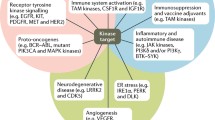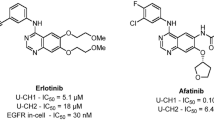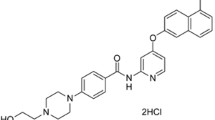Abstract
The multifunctional cytokine, TGF-β, is often overexpressed in human tumors and in preclinical studies has been demonstrated to have autocrine and paracrine protumor activities including immune evasion, invasiveness, epithelial to mesenchymal transition, angiogenesis, tumor-stromal interactions, survival, induction of tumor interstitial pressure, and decreased drug penetration. These findings suggest that antagonism of the TGF-β pathway may be of benefit in the treatment of cancer. One attractive target, the type I TGF-β receptor (ALK5) has an intracellular serine/threonine kinase, which is required for TGF-β signaling and is amenable to inhibition by small molecule, ATP binding site-targeted kinase inhibitors.
We utilized the growing understanding of the interactions between kinases and their ATP binding site inhibitors to pursue a number of focused lead discovery strategies. In one of those, we developed a novel shape-based pharmacophore model and discovered a potent, selective ALK5 inhibitor, HTS466284. ALK5 inhibitors obtained from several focused lead discovery strategies were optimized for oral bioavailability and in vivo activity resulting in the development of orally active ALK5 inhibitors such as SM16, which show potent antitumor activity in rodent tumor models.
Access this chapter
Tax calculation will be finalised at checkout
Purchases are for personal use only
Preview
Unable to display preview. Download preview PDF.
Similar content being viewed by others
References
Elliott RL, Blobe GC. Role of transforming growth factor beta in human cancer. J Clin Oncol 2005; 23:2078–2093.
Mauviel A. Transforming growth factor-beta: a key mediator of fibrosis. Methods Mol Med 2005;117:69–80.
Muraoka-Cook RS, Dumont N, Arteaga CL. Dual role of transforming growth factor β in mammary tumorigenesis and metastatic progression. Clin Cancer Res 2005;11:937s–943s.
Siegel PM, Massagué J. Cytostatic and apoptotic actions of TGF-beta in homeostasis and cancer. Nat Rev Cancer 2003;3:807–821.
Lammerts E, Roswall P, Sundberg C, et al. Interference with TGF-beta1 and-beta3 in tumor stroma lowers tumor interstitial fluid pressure independently of growth in experimental carcinoma. Int J Cancer 2002;102:453–462.
Salnikov AV, Roswall P, Sundberg C, Gardner H, Heldin NE, Rubin K. Inhibition of TGF-beta modulates macrophages and vessel maturation in parallel to a lowering of interstitial fluid pressure in experimental carcinoma. Lab Invest 2005;85:512–521.
Yingling JM, Blanchard KL, Sawyer JS, Development of TGF-beta signaling inhibitors for cancer therapy. Nat Rev Drug Discov 2004;3:1011–1022.
Derynk R, Zhang YE. Smad-dependent and Smad-independent pathways in TGF beta family signalling. Nature 2003;425:577–584.
Massagué J. Mechanisms of TGF-beta signaling from cell membrane to the nucleus. Cell 2003;113:685–700.
Huse M, Chen YG, Massagué J, Kuriyan J. Crystal structure of the cytoplasmic domain of the Type I TGFβ receptor in complex with FKBP12. Cell 1999;96:425–436.
Taylor SS, Radzio-Andzelm E. Protein kinase inhibition: natural and synthetic variations on a theme. Curr Opin Chem Biol 1997;1(2):219–226.
Deng Z, Chuaqui C, Singh J. Structural interaction fingerprint (SIFt): a novel method for analyzing three-dimensional protein-ligand binding interactions. J Med Chem 2004;47:337–344.
Chuaqui C, Deng Z, Singh J. Interaction profiles of protein kinase-inhibitor complexes and their application to virtual screening. J Med Chem 2005;48(1):121–133.
Eyers PA, Craxton M, Morrice N, Cohen P, Goedert M. Conversion of SB203580 insensitive map kinase family members to drug sensitive forms by a single amino-acid substitution. Chem Biol 1998;5:321–328.
Wang Z, Canagarajah B, Boehm J, et al. Structural basis of inhibitor selectivity in MAP kinases. Structure 1998;15: 1117–1128.
Singh J, Chuaqui CE, Boriack-Sjodin PA, et al. Successful shape-based virtual screening: the discovery of a potent inhibitor of the type I TGFbeta receptor kinase (TbetaRI). Bioorg Med Chem Lett 2003;13:4355–4359.
Suzuki E, Kin S, Cheung HK, et al. A novel small-molecule inhibitor of transforming growth factor beta type I receptor Kinase (SM16) inhibits murine mesothelioma tumor growth in vivo and prevents tumor recurrence after surgical resection. Cancer Res 2007;67(5):2351–2359.
Lu SL, Reh D, Li AG, et al. Overexpression of transforming growth factor beta1 in head and neck epithelia results in inflammation, angiogenesis, and epithelial hyperproliferation. Cancer Res 2004;64:4405–4410.
Sawyer JS, Anderson BD, Beight DW, et al. Synthesis and activity of new aryl-and heteroaryl-substituted pyrazole inhibitors of the transforming growth factor-beta type I receptor kinase domain. J Med Chem 2003;46:3953–3956.
Kirkpatrick P. Virtual screening: different routes to the same answer. Nat Rev Drug Discov 2003;2:947.
Singh J, Ling LE, Sawyer JS, Lee WC, Zhang F, Yingling J. Transforming the TGFbeta pathway: convergence of distinct lead generation strategies on a novel kinase pharmacophore for TbetaRI (ALK5). Curr Opin Drug Discov Dev 2004;7:437–445.
Muraoka-Cook RS, Shin I, Yi JY, et al. Activated type I TGFbeta receptor kinase enhances the survival of mammary epithelial cells and accelerates tumor progression. Oncogene 2005;25:3408–3423.
Tojo M, Hamashima Y, Hanyu A, et al. The ALK-5 inhibitor A-83-01 inhibits Smad signaling and epithelial-to mesenchymal transition by transforming growth factor-beta. Cancer Sci 2005;96:791–800.
Uhl M, Aulwurm S, Wischhusen J, et al. SD-208, a novel transforming growth factor beta receptor I kinase inhibitor, inhibits growth and invasiveness and enhances immunogenicity of murine and human glioma cells in vitro and in vivo. Cancer Res 2004;64:7954–7961.
Hayashi T, hideshima T, Nguyen AN, et al. Transforming growth factor beta receptor I kinase inhibitor down-regulates cytokine secretion and multiple myeloma cell growth in the bone marrow microenvironment. Clin Cancer Res 2004;10:7540–7546.
Choi KC, Kang SK, Nathwani PS, Cheng KW, Auersperg N, Leung PC. Differential expression of activin/inhibin subunit and activin receptor mRNAs in normal and neoplastic ovarian surface epithelium (OSE). Mol Cell Endocrinol 2001;174:99–110.
Di Simone N, Crowley WF, Jr., Wang QF, Sluss PM, Schneyer AL. Characterization of inhibin/activin subunit, follistatin, and activin type II receptors in human ovarian cancer cell lines: a potential role in autocrine growth regulation. Endocrinology 1996;137:486–494.
Kleeff J, Ishiwata T, Friess H, Buchler MW, Korc M. Concomitant over-expression of activin/inhibin beta subunits and their receptors in human pancreatic cancer. Int J Cancer 1998;77:860–868.
Wildi S, Kleeff J, Maruyama H, Maurer CA, Buchler MW, Korc M. Overexpression of activin A in stage IV colorectal cancer. Gut 2001;49:409–417.
Ito I, Minegishi T, Fukuda J, Shinozaki H, Auersperg N, Leung PC. Presence of activin signal transduction in normal ovarian cells and epithelial ovarian carcinoma. Br J Cancer 2000;82(8):1415–1420.
Steller MD, Shaw TJ, Vanderhyden BC, Ethier JF. Inhibin resistance is associated with aggressive tumorigenicity of ovarian cancer cells. Mol Cancer Res 2005;3:50–61.
Landis MD, Seachrist DD, Montanez-Wiscovich ME, Danielpour D, Keri RA. Gene expression profiling of cancer progression reveals intrinsic regulation of transforming growth factor-beta signaling in ErbB2/Neu-induced tumors from transgenic mice. Oncogene 2005;24:5173–5190.
Lahn M, Kloeker S, Berry BS. TGF-beta inhibitors for the treatment of cancer. Expert Opin Invest Drugs 2005;14:629–643.
Author information
Authors and Affiliations
Editor information
Editors and Affiliations
Rights and permissions
Copyright information
© 2008 Humana Press Inc., Totowa, NJ
About this chapter
Cite this chapter
Ling, L.E. et al. (2008). The Use of Virtual Screening in ALK5 Kinase Inhibitor Discovery and Validation of Orally Active ALK5 Kinase Inhibitors in Oncology. In: Jakowlew, S.B. (eds) Transforming Growth Factor-β in Cancer Therapy, Volume II. Cancer Drug Discovery and Development. Humana Press. https://doi.org/10.1007/978-1-59745-293-9_41
Download citation
DOI: https://doi.org/10.1007/978-1-59745-293-9_41
Publisher Name: Humana Press
Print ISBN: 978-1-58829-715-0
Online ISBN: 978-1-59745-293-9
eBook Packages: MedicineMedicine (R0)




